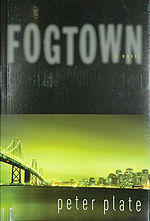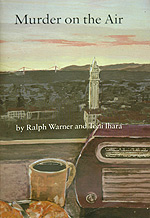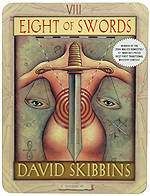Berkeleyan
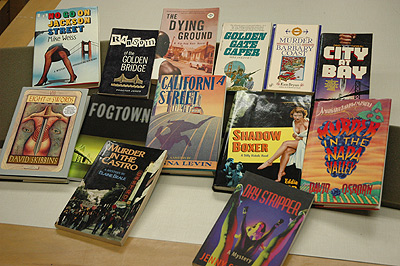 |
More than 1,200 Bay Area mysteries (a small number of which are shown at left) are listed at the Golden Gate Mysteries website, created by Bancroft Library principal cataloger Randal Brandt. (Cathy Cockrell photo) |
Sleuthing out Bay Area mystery novels
Bancroft librarian tracks down suspects for ambitious online bibliography
![]()
| 12 January 2006
With its storied history, signature landmarks, and abundant atmospheric fog, San Francisco has long been a favored stomping ground of literary sleuths. Just how much crime has bloodied this ground is apparent by visiting Golden Gate Mysteries, an annotated bibliography found on the Berkeley Library website. There mystery fans will find the titles of hundreds of novels set in San Francisco and environs, featuring gumshoes as diverse as the names in a Frisco phone book and plots as twisted as Lombard Street.
This prodigious (and growing) compendium is the brainchild of Bancroft Library cataloger Randal Brandt, a mystery aficionado with a passion for following book-related leads and sharing his discoveries. "If I'm going to read them anyway," he puts it plainly, "I might as well add them to the bibliography."
Read them he does - by the dozens - adding a short plot summary for Golden Gate Mysteries (bancroft.berkeley.edu/sfmystery/) each time he finishes a book. With new entries coming, as well, from book-jacket copy and volunteer contributors, including his wife, "It's surprising how fast it grows," Brandt says. He began his list in fall 2002 and is now up to 1,268 titles, and counting.
Sleuths of all persuasions
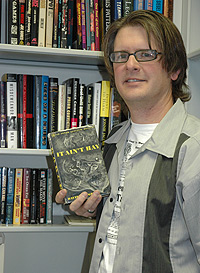 Bancroft Library principal cataloger Randal Brandt (above) married his bibliographic research skills with his love of a good whodunit to create the Golden Gate Mysteries website. He's particularly fond of the author David Dodge, whose It Ain't Hay (1946) describes the world of marijuana smugglers and ends on a wharf in Half Moon Bay. (Cathy Cockrell photo) |
A sampling of Golden Gate mysteries of more recent vintage features detective Sharon McCone, catapulted into action after a trove of priceless Torah scrolls shows up in a San Francisco flea market (Marcia Muller's Leave a Message for Willie, 1984); private-eye Jeremiah St. John and sidekicks Chief Moses (a Seminole Indian) and Michelle "Mickey" Farabaugh (discharged from the police force after posing for a "Women in Blue" Playboy spread) probing the murder of a sleazy drug attorney (William Babula's St. John's Baptism, 1988); stripper Aubrey Lyle looking into the disappearance of coworker Plushious Velvett, after finding a bloody breast implant suggestive of foul play (Jenny Scholten's Slay Me Tender, 2001); and the elderly Sister Mary Helen investigating a mysterious death outside a shelter for homeless women (Requiem at the Refuge by Sister Carol Anne O'Marie, 2000). Gay public defender Henry Rios investigates the slaying of a wealthy wastrel (and one-time lover) in Michael Nava's The Little Death (1986); and Sam Spade, prototypical hardboiled PI, hunts down that priceless raptor statuette (Dashiell Hammett, The Maltese Falcon, 1930).
Brandt also ventures beyond the City's limits to the greater Bay Area: Nichelle Tramble's The Dying Ground (2001) stars a former Cal baseball player whose sleuthing leads to the mean streets of the Oakland drug scene, while homicide detective Jill Smith figures large in Susan Dunlap's slew of how-Berkeley-can-you-be mysteries - as do massage therapists (Diamond in the Buff, 1990), parking-meter vandals (Time Expired, 1993), and naked protesters and former '60s radicals (Sudden Exposure, 1996). The Napa and Silicon valleys are also well represented.
Or, for a bit of the Berkeley campus in your page-turner, there's Anthony Boucher's 1937 mystery, The Case of the Seven of Calvary, featuring International House residents and a professor-turned gumshoe (reportedly based on Arthur Ryder, an early 20th century Berkeley Sanskrit scholar). A Telegraph Avenue tarot-card reader is the protagonist of David Skibbins' Eight of Swords (2005).
A David Dodge fan
Excerpts from the pages of Golden Gate mysteries
- Fogtown by Peter Plate (Seven Stories Press, 2004)
- Murder on the Air by Ralph Warner and Toni Ihara (Nolo Press, 1984)
- Eight of Swords by David Skibbins (Thomas Dunne Books/St. Martin's Minotaur, 2005) |
A native of Reedley, just south of Fresno, and a librarian at Berkeley since 1991, Brandt's campus assignments have had a consistent Golden State focus. After cataloging California maps and California Indian materials, he spent seven years at the Water Resources Center Archives before becoming the Bancroft's principal cataloger in late 2001.
His weakness for Bay Area crime fiction started with a literary admiration for David Dodge (1910-1974), a Berkeley-born writer of detective and travel literature. In the 1940s, Dodge penned four novels set in and around San Francisco, "effortlessly weaving" his personal knowledge of arcane tax law (he worked as an accountant) into his plots featuring tax expert and reluctant detective James "Whit" Whitney, says Brandt. Dodge is best known for his tale of jewel robbery on the French Riviera, To Catch a Thief (1952), which Alfred Hitchcock brought to the screen.
Collaborating with Dodge's daughter, Kendal Dodge Butler, Brandt created an exhaustive website, A David Dodge Companion (www.david-dodge.com), an online tribute packed with biographical background, detailed descriptions of the author's work, book-jacket art, even Dodge family photos and home-movie footage. The website has been featured in the San Francisco Chronicle and praised as "one of the finest single-author sites" by the online magazine Thrilling Detective.
Golden Gate Mysteries benefits from Brandt's bibliographic-research skills as well as access to a collection of nearly 200 San Francisco detective books that the Bancroft acquired from Don Herron, leader of the city's popular Dashiell Hammett walking tours. Building on Herron's extensive checklist of San Francisco crime fiction, Brandt tracks down additional titles using online databases, published bibliographies, tips from fellow mystery enthusiasts, and visits to rummage sales and used-book stores.
"Dumb, blind luck" is his "most successful method of late," he says. In used-book shops, his hand has been known to migrate "strangely" to volumes that, upon closer inspection, turn out to be Bay Area crime novels; at the Oakland Museum's annual White Elephant Sale, he found the above-mentioned red-light mystery, Slay Me Tender, at the "very bottom" of a heap of books.
Bancroft genre fiction
At times, Brandt's avocation and vocation elegantly converge, as a recent "startling discovery" illustrates: a new book on Bay Area true-crime cases, which he received as a gift from his sister, included a chapter on Theo Durrant, a medical student convicted in 1895 of brutally raping and murdering two young women in a San Francisco church. "There was a brief reference," he says, "to a 'short novel' based on the case," Letter F, or, Startling Revelations in the Durrant Case, written by Jacob Taussig and published in 1895, before Durrant's conviction. A search of national library databases revealed that the Bancroft holds the only known copy of the book. "I've just read it and it's a corker," he reports. "I'm revising the catalog record; it was originally cataloged as a biography, not fiction."
He's excited about - and hopes to see expanded - the Bancroft's holdings of genre fiction, a term that refers to mysteries, science fiction, and other categories of popular fiction with established conventions and thriving fan bases. Some in the English department share his enthusiasm. In 2000, the Bancroft acquired a collection of the original publications of short stories by the celebrated Berkeley science-fiction author Philip K. Dick, soon after the Faculty Advisory Committee for 20th Century Literary Collecting recommended acquisition of Dick's work.
Genre fiction "deserves to be collected" by institutions like the Bancroft, Brandt believes. "Any copy will do," he notes, if one is approaching a work solely from a textual standpoint. But if a student or literary scholar is interested in an author's publishing history, it's invaluable to examine not just the blockbusters but the low-budget paperbacks with original cover art and the early hardcovers, complete with dust jackets - which the Bancroft carefully preserves.
"Rare-book and special-collections librarians," Brandt says, "have the same Hippocratic oath that doctors do: 'First, do no harm.'"
Later this year a new publishing venture, Hard Case Crime, plans to put out Dodge's final, unpublished novel, The Last Match. The electronic file they'll be using is the one that Brandt created, in a labor of love, after discovering the author's original manuscript among the Dodge papers in his care. It was composed on a typewriter, with corrections and additions scrawled in the margins; Brandt retyped the entire manuscript, incorporating the author's changes.
"I did it because I wanted to read it," he says.


